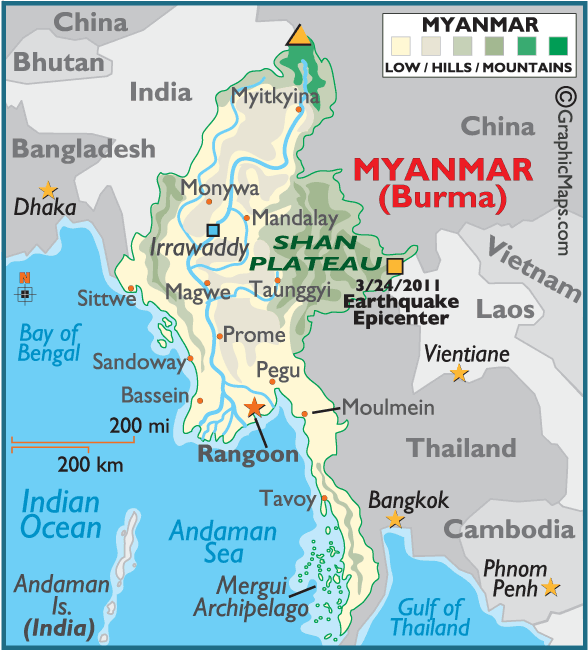
Myanmar
2012
| Location: | South East Asia |
| Population: | 42,909,500 |
| Area: | Coastline 1,199 miles (1,930 km)  261,970 sq miles (678,500 sq km) |
| Elevation: | Highest Point Hkakabo Razi - 19,294 ft. (5,881 m) |
Burma, the "Golden Land," is a mostly Buddhist country whose history can be
traced back to the Neolithic era.
The first known city-states emerged in central Burma around the 2nd century
BC by Pyu tribes who initiated trade with India and brought Buddhism to the
region.
[Pagan] Repeated attacks by the Kingdom of Nanzhao during the 8th century AD
forced the decline of the Pyu culture, and by the late 9th century Nanzhao
had founded a small settlement at Pagan (Bagan).
The Pagan civilization flourished throughout the 11th century, and
ultimately absorbed the surrounding settlements, forming the Pagan Empire.
Together with the Khmer Empire, the Pagan Empire was one of the main powers
of Southeast Asia at the time, and subsequently the Burmese language and
culture dominated the land.
However, the Pagan's were no match for Mongol invaders, and after repeated
invasions the empire collapsed in 1287.
The Mongols migrated out of the region shortly after the fall of the Pagans,
and several smaller kingdoms existed, sparking an era of wars and switching
alliances.
In 1364 the successor state of Ava was founded in central Burma, and
attempted to reassemble the Pagan Empire. Unfortunately, while it was
successful in reigning the Toungoo and peripheral Shan states, it failed to
conquer the remaining states, and was eventually overrun by Toungoo forces
in 1555.
[Tabinshwehti] Tabinshwehti, Toungoo's overly ambitious king, conquered a
vast amount of Southeast Asia throughout the 16th century, becoming the
area's largest empire in history. However, after the death of Tabinshwehti's
successor, Bayinnaung, the empire began to unravel, before completely
dissolving in 1599.
Through the next two centuries, Burma fell under the ruling of numerous
small kingdoms, and was conquered by the British in the 19th century and
incorporated into its Indian Empire.
In the colonial era, Rangoon was named capital of Burma, becoming an
important port between Calcutta and Singapore.
Civil unrest prevailed through the British ruling, and violent protests were
carried out for decades.
During the Second World War, the region of Burma became a major
battleground, completely devastating the country, and causing the British
administration to break down; thus allowing Burma their chance at gaining
independence in 1948.
Since 1962, the military has controlled the country, even failing to turn
over the governmental power to the opposition party that won a landslide
victory in the 1990 general election.
On November 6, 2005, the administrative capital was moved from the city of
Rangoon to the newly built city of Nay Pyi Taw. Much of this city is still
under construction, and is set to be completed sometime in 2012.
[Burma] The country of Burma is replete with natural resources, but growth
and progress are stifled by strict government controls and serious financial
mismanagement.
In 2008, a "discipline-flourishing democracy" was promised, and a new
constitution was drafted. General elections were held in 2010, and the
military-backed Union Solidarity and Development Party was victorious.
The beautiful and mysterious city of Rangoon is the principal port, and
tourists are attracted by the city's large number of ancient golden pagodas
(monuments to Buddha) that still stand.
